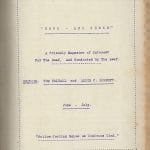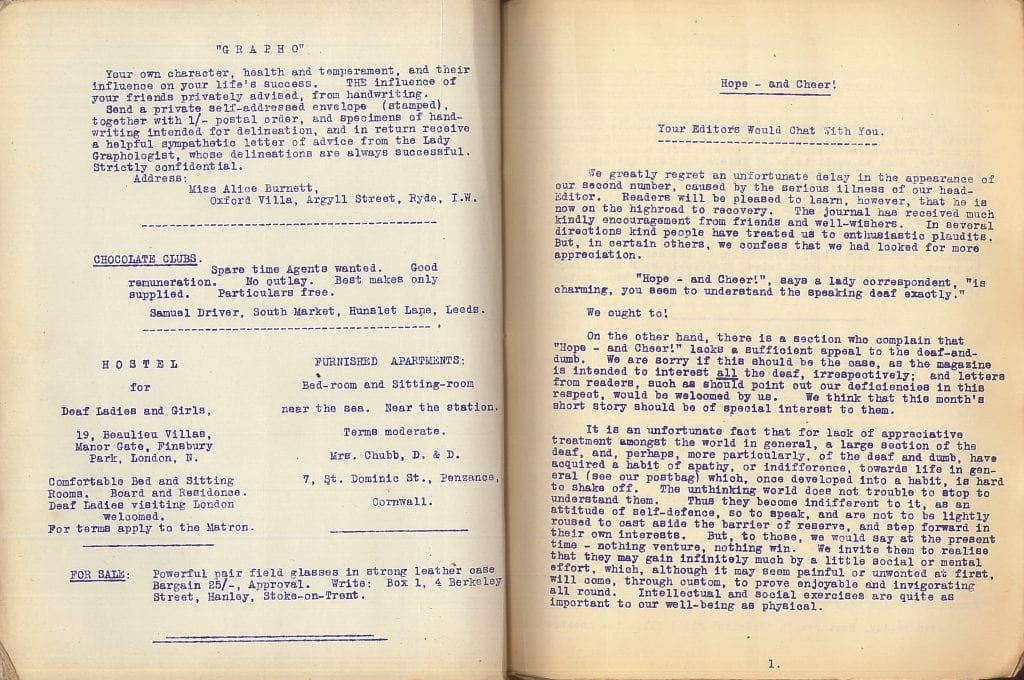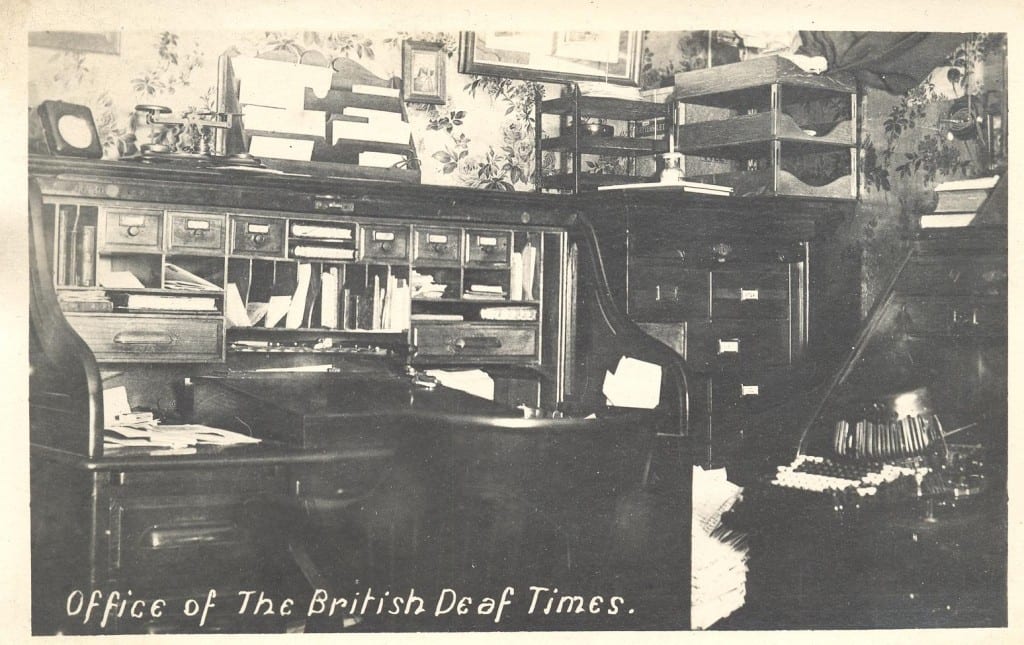 In an untidily amateurishly stitched together collection of programmes and oddments for the Royal Association in Aid of the Deaf and Dumb in our collection*, there lies a curious mimeographed magazine, called – with the title in inverted commas – “Hope – and Cheer!” It continues with the sub-heading, ‘A friendly Magazine of Interest For The Deaf, And Conducted By The Deaf.’ It was edited by Tom Kelsall and Alice Christina Burnett (1874-1961). It assures us it was produced by Deaf people, so we must accept that Kelsall and Burnett were deaf, although Alice is not described as such in any census I could see. As we have discussed before though, that could be for a number of reasons, for example because someone else (her husband or father) filled in the form, or because she did not think it was a disability, or perhaps she was not profoundly deaf.
In an untidily amateurishly stitched together collection of programmes and oddments for the Royal Association in Aid of the Deaf and Dumb in our collection*, there lies a curious mimeographed magazine, called – with the title in inverted commas – “Hope – and Cheer!” It continues with the sub-heading, ‘A friendly Magazine of Interest For The Deaf, And Conducted By The Deaf.’ It was edited by Tom Kelsall and Alice Christina Burnett (1874-1961). It assures us it was produced by Deaf people, so we must accept that Kelsall and Burnett were deaf, although Alice is not described as such in any census I could see. As we have discussed before though, that could be for a number of reasons, for example because someone else (her husband or father) filled in the form, or because she did not think it was a disability, or perhaps she was not profoundly deaf.
Alice was born in Edinburgh, on the 19th of September, 1874, daughter of Alice Stuart and George Burnett, who was Lord Lyon King of Arms. A living relative of his was also a Herald. In 1881 they lived at 21 Walker Street, Edinburgh. In 1902 she married Louis Holloway, and in 1911 they were living on a private income, in Oxford Villas, Ryde, on the Isle of Wight.
As an aside, it is very curious that Louis, born in Southampton, was living on his own means in 1901, with his father who was a bricklayer’s labourer. Louis was 26 – how did he make his money, and how did he meet and woo Alice?
I have not been able to pin down Alice’s fellow editor, Tom Kelsall, who had been seriously ill, delaying this second edition of “Hope – and Cheer!” that came out in June-July, whatever year. Logic suggests they were quite familiar with each other from some social situation, and had had ample time to discuss this magazine before starting it. The content suggests it was a wartime production. I do not suppose it lasted very long. There is a rather maudlin tale written by Alice, called The lonely man and the lonely girl, that tells us how a Deaf girl starts a correspondence with a soldier, and it all ends happily –
He held out his arms to her.
And she went to them.
“Oh – Ted – this seems like a beautiful dream!” she enunciated.
He seemed so strong, so kind, so good to trust in!
“It is – the dream of my life, but it’s quite real,” he answered on his fingers – “Before my leave is over, then?”
She nodded shyly.
There is a paragraph, with ‘Our Monthly Problem – Whether you would rather be Deaf, of Blind.’ I recall having seen this sort of item before, even in old copies of British Deaf Times.
Cutliffe Hyne dwells upon the doom of deafness. Sir Arthur Pearson declares deafness to be worse than blindness, and Sir Ferederick Milner agrees with him. Mr. Wilson of the National Hostels for Deafened Soldiers and Sailors, on the contrary , say, “I would rather be deaf, dumb, and have two wooden legs, and only one arm, than be blind.” What is your opinion? and why? We award a prize of 3/- for the best letter, of within 200 words, on this subject.
Alice also offers handwriting analysis under the name ‘Grapho.’
“Hope – and Cheer!” contains some adverts. One from a widow, Mrs Margaret Chubb (1854-1950), formerly Jenkins, was offering rooms to rent in Penzance. She was Deaf from Smallpox, aged 3 according to the 1911 census, when she was living at the same address with her son. Her husband, who she married in 1888, was Richard Chubb (1852-?), a tailor from Devonshire. Richard had also been ‘deaf and dumb’ and attended the Institution for the Blind, Deaf and Dumb at Walcot, Bath, where we find him in 1861, aged nine.
Finally, there is an advert from Samuel Driver of Leeds for ‘agents’ to run ‘Chocolate Clubs’ which I assume were along the lines of Christmas clubs. If I have identified the correct Samuel, born in Keighley in 1888, he was not deaf – but his mechanic father Thomas Driver (1859-?) was, as was also their lodger, Eliza Dunn (b.ca.1868), who worked as a ‘Worsted Rover’. Thomas, son of a mechanic Wilkinson Driver, was deaf from childhood and had already been identified as such aged two.
How did these people find out about “Hope – and Cheer!”? How did Alice Holloway/Burnett and Tom Kelsall meet, and how did they distribute the magazine? How long did it survive? Are other copies in existence, or it this unique? As with the previous post, we can see that exploring one trivial thing can open a world of forgotten connections. There are plenty of further avenues to explore with this disparate collection of people.
 Click images for a larger size.
Click images for a larger size.
If you can identify Kelsall please leave a comment.
*They were bound by L.Burroughs, ‘deaf and dumb’ in July, 1922.
UPDATE – [2/7/18] a relative by marriage of Alice adds this information – “In the 1939 Register Ref: RG101/2650C/005/18 Alice and Louis are living at 53 Argyll Street, Ryde, I.O.W. Her Birthdate is confirmed as 19 Sep 1874 and his given as 17? Feb 1880. Her occupation is given as “W V S Red Cross Hospital Supply Service” and his as “Private Means” Her Death was registered aged 86 Q1 1961 vol 6b page 1093 Isle of Wight His death registered Q3 1973 Isle of Wight. His Birth date given as 14 Feb 1880.”
Alice Burnett
1881 Scottish Census – Parish: St George; ED: 91; Page: 4; Line: 1; Roll: cssct1881_283
1901 Scottish Census – Parish: Edinburgh St George; ED: 1; Page: 9; Line: 21; Roll: CSSCT1901_363
1911 Census – Class: RG14; Piece: 5721; Schedule Number: 122
https://en.wikipedia.org/wiki/House_of_Burnett
Margaret Chubb
1891 Census – Class: RG12; Piece: 1857; Folio: 74; Page: 11 – with Richard Chubb
1911 Census – Class: RG14; Piece: 14071; Schedule Number: 173
1939 Register; Reference: RG 101/6699A
Richard Chubb
1861 Census – Class: RG 9; Piece: 1690; Folio: 53; Page: 5; GSU roll: 542851
Thomas Driver
1861 Census – Class: RG 9; Piece: 3227; Folio: 45; Page: 37; GSU roll: 543099
1901 Census – Class: RG13; Piece: 4076; Folio: 174; Page: 28
Louis Holloway
1901 Census – Class: RG13; Piece: 1079; Folio: 7; Page: 5
 Close
Close





